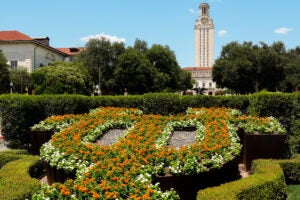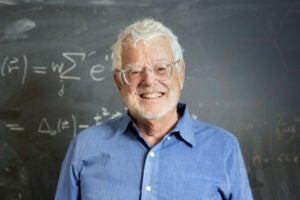
Watching professional basketball today with its one-named superstars and eight-figure salaries it can be a little hard to imagine the sport’s humble origin more than 120 years ago as a simple game that employed peach baskets as goals and used a soccer ball.
In 1891 a young minister named James Naismith created the game as a way to stay fit during harsh Massachusetts winters. He wrote a simple game plan, comprising 13 rules, and posted the typewritten document in the Springfield, Mass., YMCA gym where he worked.
Today, you can see those very pages at the Blanton Museum as part of an exhibit called “The Rules of Basketball: Works by Paul Pfeiffer and James Naismith’s ‘Original Rules of Basket Ball,’ ” on view until Jan. 13, 2013.

The original rules come to the Blanton by way of Austinites David and Suzanne Booth, who purchased the document at auction in 2010. “The Rules” will eventually be returned to the University of Kansas (David Booth’s alma mater) and are the subject of “There’s No Place Like Home,” a documentary from ESPN Films that tells the story of the document’s acquisition by the Booths and the journey to bring it back to Kansas, where Naismith coached his first team.
For its exhibit, the Blanton has married the historical with the aesthetic, pairing the rules document with a body of work by Paul Pfeiffer, an artist who examines the sport from a psychological angle.
“It’s a unique project, an absolutely unprecedented opportunity for those of us at UT and in this audience of Austin to get to experience the original document written in the 1890s that establishes the rules of the game in association with the work of a contemporary artist who has been meditating on basketball and its effects for many years,” says Annette DiMeo Carlozzi, the Blanton’s curator-at-large.
In fact, most of Pfeiffer’s work in the Blanton’s exhibition was created during the first decade of the 21st century, a time when digital media was new. The raw materials Pfeiffer manipulates for his video sculptures and photographs include commercial VHS tapes, DVDs and photographs from the NBA archives, using vintage devices to project the moving images. The artist reframes the players, the ball and the architecture of the arena to underline the sublime potential of the game and its metaphoric undertones.
Alongside Pfeiffer’s works from the early 2000s is a new work inspired by the legendary NBA player Wilt Chamberlain. Pfeiffer re-created Chamberlain’s famous 100-point game in 1962, which was not captured on video, and a room from Chamberlain’s playboy-style mansion.
Pfeiffer’s work reflects on the global phenomenon of the sport in a way that Naismith couldn’t have imagined. The simple game invented near the turn of the 20th century is a far cry from today’s professional game, governed by the 65-page NBA rulebook.
The Blanton Museum isn’t the only spot on campus celebrating basketball this fall:
The Stark Center for Physical Culture and Sport hosts “Basketball and American Culture,” featuring NBA Hall of Famer and former U.S. Senator Bill Bradley, Nov. 29.
“Basketball: Power and Play,” an exhibit of photographs from the 1940s and 1950s, is on view at the Harry Ransom Center through Dec. 9.



